Synthesis and photophysical properties of Ir(iii)/Re(i) dyads: control of Ir→Re photoinduced energy transfer†
Abstract
A series of dinuclear Ir(III)/Re(I) complexes has been prepared based on a family of symmetrical bridging ligands containing two bidentate N,N′-chelating pyrazolyl–pyridine termini, connected by a central aromatic or aliphatic spacer. The Ir(III) termini are based on {Ir(F2ppy)2}+ units (where F2ppy is the cyclometallating anion of a fluorinated phenylpyridine) and the Re(I) termini are based on {Re(CO)3Cl} units. Both types of terminus are luminescent, with the Ir-based unit showing characteristic strong, structured phosphorescence in the blue region (maximum 452 nm) with a triplet excited state energy of 22 200 cm−1 and the Re-based unit showing much weaker and lower-energy phosphorescence (maximum 530 nm) with a triplet excited state energy of 21 300 cm−1. The energy gradient between the two excited states allows for partial Ir→Re photoinduced energy-transfer, with substantial (but incomplete) quenching of the higher-energy Ir-based emission component and sensitised emission – evidenced by an obvious grow-in component – on the lower-energy Re-based emission. The Ir→Re energy-transfer rate constants vary over the range 1–8 × 107 s−1 depending on the bridging ligand: there is no simple correlation between bridging ligand structure and energy-transfer rate, possibly because this will depend substantially on the conformation of these flexible molecules in solution. To test the role of ligand conformation further, we investigated a complex in which the bridging chain is a (CH2CH2O)6 unit whose conformation is known to be solvent-polarity dependent, with such chains adopting an open, elongated conformation in water and more compact, folded conformations in organic solvents. There was a clear link between the rate and extent of Ir→Re energy-transfer which reduced in polar solvents as the chain became elongated and the Ir/Re separation was larger; and increased in less polar solvents as the chain adopted a more compact conformation and the Ir/Re separation was reduced.


 Please wait while we load your content...
Please wait while we load your content...